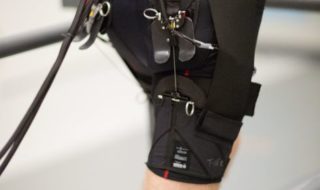An innovative soft exosuit developed at Harvard University greatly reduces the metabolic cost of running by 5.4%. Amateur or professional athletes alike could greatly improve their performance by using this assistive technology. For instance, a 26.2-mile marathon would feel like running a 24.9-mile one or a running pace of 9:14 minutes/mile could be improved to 8:49 minutes/mile. All the hard work is made by the suit so you need no extra training. The researchers who invented and tested the suit say it could prove ideal for athletes looking to augment their performance or for those recovering from an injury. It’s not the very portable, not yet at least — the exosuit is tethered and use is confined to a treadmill for now.

The exosuit is textile-based and lightweight ensuring it moves along with the body. It’s made of flexible wires that connect the fabric anchored to the back of the thigh and waist belt to an external actuation unit.
When a subject runs on a treadmill wearing the tethered suit, the actuator unit pulls the wires as if it were a second pair of hip extensor muscles.

The researchers at Wyss Institute and John A. Paulson School of Engineering and Applied Sciences (SEAS) at Harvard University were interested which of two different ‘assistance profiles’ was better, i.e. which had the least metabolic cost. One of the modes is based on human biology and applies force starting at the point of maximum hip extension as observed in normal running. The other mode is based on simulations previously made by a group from Stanford University which found applying force slightly later in the running stride could be more optimal.
Strikingly, it was this second, ‘unnatural’ model that provided the best performance. Compared to the biology-based profile, the simulation-based profile reduced metabolic cost by a factor of two.
“Our work at the Wyss is biologically inspired and, as shown by Conor’s team’s advance, sometimes we learn that a conventional biological view of a mechanism is not really how living systems work; we need to place individual components — in this case, a human hip joint — in context of the living whole. When we do this right, transformative new technologies emerge,” says the Wyss’ Founding Director Donald Ingber, in a statement. “Studies like this are also a great example of the power of thinking beyond the limitations that Nature has handed us and asking, ‘Can we do better?'”
When the team analyzed what happens when a subject’s hip joints were being assisted by the exoskeleton’s actuating wires, the researchers found that the simulation-based profile also acted on other muscles and components of the limbs. The profile affected the knee extension, as well as the forces between the foot and the ground, whereas the biology-based profile did not.
“The biological profile only takes into account the amount of torque in the hip joint, but the human body is not a series of independently acting parts — it’s full of muscles that act on multiple joints to coordinate movement,” said Postdoctoral Fellow Giuk Lee in a statement. “Applying force to the hip affects the whole body system, and we need to consider that in order to give the best assistance.”
Only two actuation profiles were studied which means there’s a good chance the cost of running can be further reduced with some tweaks. The real innovation, however, would be to make all of this system portable. An untethered system would have to integrate all of the wires, actuator units, and power in an exoskeleton that’s light and whose benefit offsets the cost of wearing it. But that’s ‘beyond the horizon’ for now, Lee says.
It might be worth noting that this study was partially funded by the Department of Defense’s DARPA Warrior Web program. Maybe one day the nation’s soldiers will be equipped with a portable version of this exosuit which will help them run faster and longer on the battlefield.
Scientific Reference: G. Lee et al. Reducing the metabolic cost of running with a tethered soft exosuit. Science Robotics, May 2017 DOI: 10.1126/scirobotics.aan6708


